How Do Motion Sensor Lights Work to Protect Your Home?
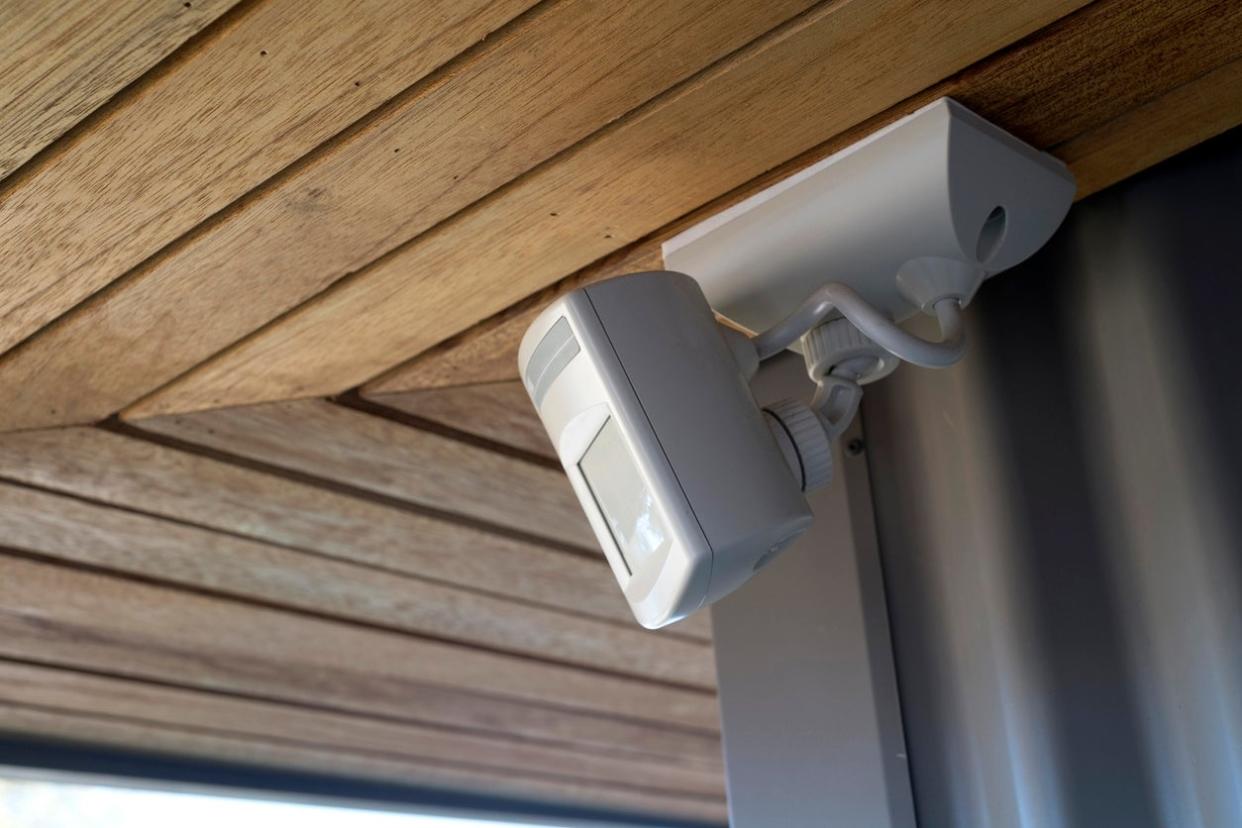
Q: The security system I’m looking to install in my home comes with a variety of motion sensor lights and other gadgets that use motion-sensing technology. I’ve never used these types of products before, so I’m looking for more information to determine if they’re worth it. How do motion sensor lights work, and how can they help protect my property?
A: Motion-sensing technology has come a long way over the past few decades. What once used to be expensive and limited to commercial applications is now widely available to the public. In fact, motion sensor lights and other motion-sensing products are an integral part of any home security system. Whether you opt for DIY setup or professional installation, motion sensors are a wise investment.
According to Hooman Shahadi, senior vice president of product at home security company SimpliSafe, “Motion-activated lights and cameras are beneficial tools for all homeowners, especially those who travel frequently, work in an office or often leave their homes unattended. Installing outdoor lights and floodlights is a simple way to deter intruders who don’t want their activities illuminated for all to see.”
Motion sensor lights come in a variety of formats. Most often they’re seen as large floodlights that will illuminate if they detect movement within their range of view. The technology is also available on a variety of security cameras with small built-in spotlights, as well as stand-alone motion sensors that don’t come with built-in lights but can be programmed to activate other devices around the home.
There’s a lot to unpack with motion sensor lights, so homeowners will want to take an in-depth look at these powerful home security gadgets.
Motion sensor lights are activated when the sensor is triggered by heat or movement.
On the most basic level, motion sensor lights are designed to trigger when they detect something moving. They allow security systems to appear as if they’re actively monitored, with lights that are turned “off” automatically turning “on” when they sense movement. This is often enough to deter even the most determined intruder, making motion detector lights a key part of exterior security.
The best floodlight cameras (we recommend the Ring Floodlight Cam Wired Plus as a dual-light option) are solid examples of motion sensor lights that can enhance a home’s security. During the day, it acts like a traditional security camera, recording objects that come into view and sending smartphone alerts when motion is detected. But at night, its role changes. Along with sending motion alerts, it can be automated to activate its brilliant motion sensor light bulb when motion is detected. This not only gives users a better view of their property, but it’s a great deterrent for unwanted visitors and is known to scare away both animals and humans.
A motion detector light needs to be properly positioned and appropriately customized, as poorly installed devices may not sense motion properly. For example, a floodlight that’s too sensitive might trigger for rustling leaves, while a sensor that’s not sensitive enough won’t trip when a person comes into range.
Those whose homes have additional security needs will want to look into systems that offer local storage instead of just cloud storage and that run on batteries instead of using a wired connection. These systems typically continue to function even during power outages, making them a reliable addition to most homes.
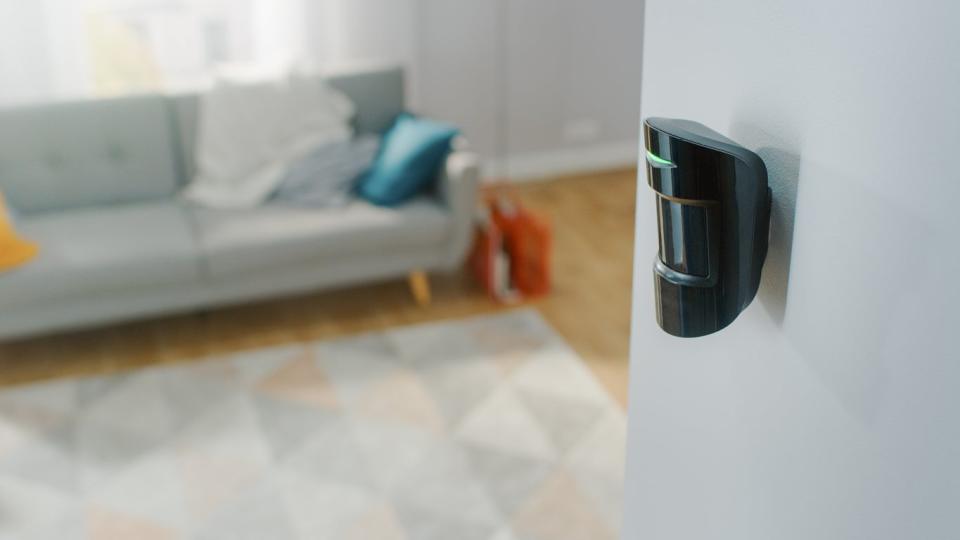
Photo: istock.com
There are several types of motion detectors that can be used for a light, with infrared and microwave sensors being the most common.
While all motion sensor lights are designed to illuminate when motion is detected, not all products go about this using the same type of technology. The most common types of motion detectors fall into two categories: infrared and microwave.
Infrared sensors (or passive infrared sensors) work by reading the heat map of their surroundings. If that heat map changes, it’ll trigger a light to activate. This technology is incredibly popular with motion sensors in home security devices, as it helps eliminate false alarms from inanimate objects without a heat signature. Conversely, it’s also great at picking up the smallest movement from animals and humans, as their heat signatures will be detected regardless of how slowly the intruder is moving.
Microwave sensors work by sending out harmless waves to their surroundings. The device will then measure how long it takes these waves to bounce back and return to the unit. This is used as a baseline measurement, and waves will be continuously sent out. If the time it takes for them to return to the unit ever differs from the baseline measurement, the motion-activated light will trigger. Any measurements different from the baseline measurement indicate that something has moved into the device’s field of view—in other words, it indicates motion.
Although microwave sensors do a great job of covering large properties, they are sometimes less accurate than infrared sensors. This is because they’re vulnerable to object interference and don’t read heat signatures. Some motion sensor lights employ both techniques to improve their performance.
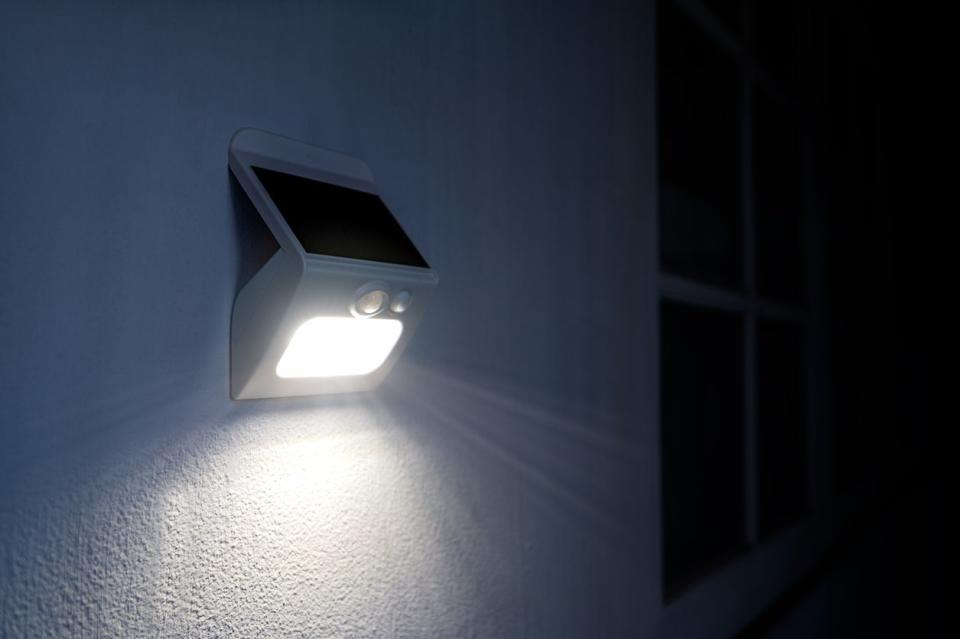
Photo: istock.com
Motion sensor lights can be programmed to switch off once they no longer detect movement, or after a certain amount of time.
The big draw of motion sensor lights is that the light sensor switch will activate automatically when the device detects movement. They can also do the opposite, switching off when motion is no longer detected. Because motion sensor lighting can automatically switch on and off, users won’t have to manually reset them after each detection event. It also means they can run autonomously once the installation process is complete.
Most users find this to be a compelling feature of motion sensor lights, as they don’t need to leave the outside of their home illuminated all night long. Instead, it’ll remain dark until an intruder (or curious animal) scurries into view. Leaving the porch light on at night is often a great security measure, though doing so can vary from neighborhood to neighborhood. Shoppers who prefer to leave a light on at night and don’t have restrictions from their HOA may want to look for motion sensor lights that can run continuously or be programmed to activate on a schedule.
Aside from their automatic light switch, motion sensors can be programmed to work with other smart-home devices. For example, if a motion sensor is running on the same network as other smart lights, it can be programmed to activate those smart lights. It can even be programmed to check a connected smart lock and automatically lock it. Shoppers interested in this functionality will want motion sensor lights that are supported by Google Home, Amazon Alexa, or Apple HomeKit.
If the motion sensor is too sensitive, it can trigger the light to come on when it senses animals, passing cars, or even leaves blowing in the wind, which can lessen the light’s effectiveness.
Motion sensors play an integral role in many of the best home security systems, including Vivint, ADT, and others. However, they’re only reliable when installed in the proper locations and customized according to the needs of each property. One of the primary complaints about motion sensors is that they’re too sensitive, tripping at the tiniest movement and activating their lights when there’s no actual threat.
Unfortunately, oversensitivity is a common issue with many entry-level motion sensors. Lower-priced products may come with less reliable sensors with fewer ways to customize their settings.
At the other end of the spectrum are premium motion sensors that offer numerous ways to optimize their performance. This includes setting up motion zones to prevent triggering motion outside the property (such as adjacent driveways or a neighbor’s backyard) and adjustable mounts so users can easily find the best viewing angle for their needs.
Products at the very top of the price range also use artificial intelligence (AI) technology to differentiate between people, animals, packages, and other common sources of motion. This technology is one of the best ways to prevent motion sensors from activating when leaves blow across a lawn or when a car drives by, as the software within the device is smart enough to “understand” what’s happening around the home.
Those who are worried about privacy can connect a light switch with the motion sensor, letting them turn the entire unit off. This prevents it from constantly illuminating if kids are playing in the backyard at night or if visitors are expected. Connecting a motion light with a switch requires a bit of technical skill, so users uncomfortable with a DIY install may want to contact a professional for assistance.
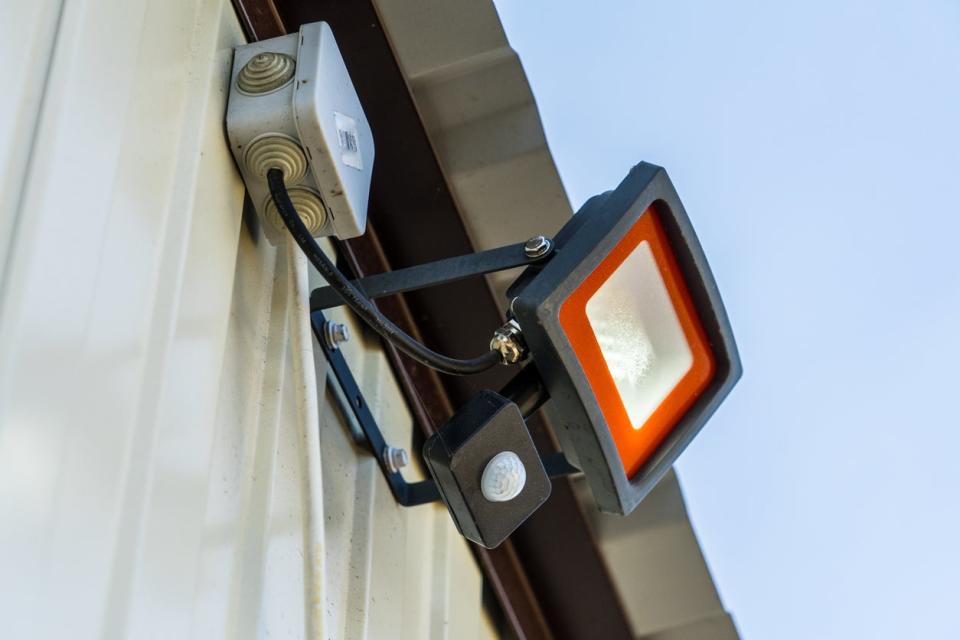
Photo: istock.com
Users can adjust a motion sensor light’s field of view by changing the height of the sensor.
Positioning is crucial to the function of a motion sensor. Aside from finding a spot that covers areas often targeted by intruders (such as doors and windows), customers will need to consider the height at which the motion sensor light will be installed.
“We recommend mounting an outdoor security camera with motion sensor lights 6 feet from the ground and angled 30 degrees down to ensure optimal visibility around the perimeter of your home,” advises Shahadi. “It’s best to direct the camera’s line of sight towards the entry points of your home—such as your driveway, front porch, or backyard—that way, if someone steps into the camera’s sight, the light will automatically ignite and deter unwanted visitors.”
Installing floodlights between 6 and 8 feet off the ground allows their sensors to send signals throughout the property without much interference. A sensor that’s placed higher up will have wider coverage, while a sensor that’s placed lower will have narrower coverage.
Users can make use of this knowledge to optimize their light’s performance. By moving the installation location of the motion sensor higher, they can increase its field of view. By lowering its installation position, they can reduce its field of view. Along with the ability to move their position, most motion sensor lights offer additional ways to fine-tune their performance. Devices that connect to a smartphone or central hub may let customers tweak settings via their smartphone, while other devices may have a physical dial that can be adjusted to change their sensitivity.
For motion sensor lights that are already installed, it makes more sense for the user to adjust these settings first before attempting to dismount and reinstall the entire device. Modifying settings with a built-in dial or with a smartphone app isn’t nearly as labor-intensive as moving a motion sensor. But if a device still isn’t working as intended, reinstalling it at a higher (or lower) location could be worth the effort.
“My number one recommendation is to add Custom Activity Zones,” says Shahadi. “For the areas that you do not want to receive alerts for, such as high-traffic roads or paths, you can tap each of these zones so that motion is only detected in areas of top concern, like your front porch.” Custom Activity Zones are specific to SimpliSafe, but similar features are offered with many other home security systems.
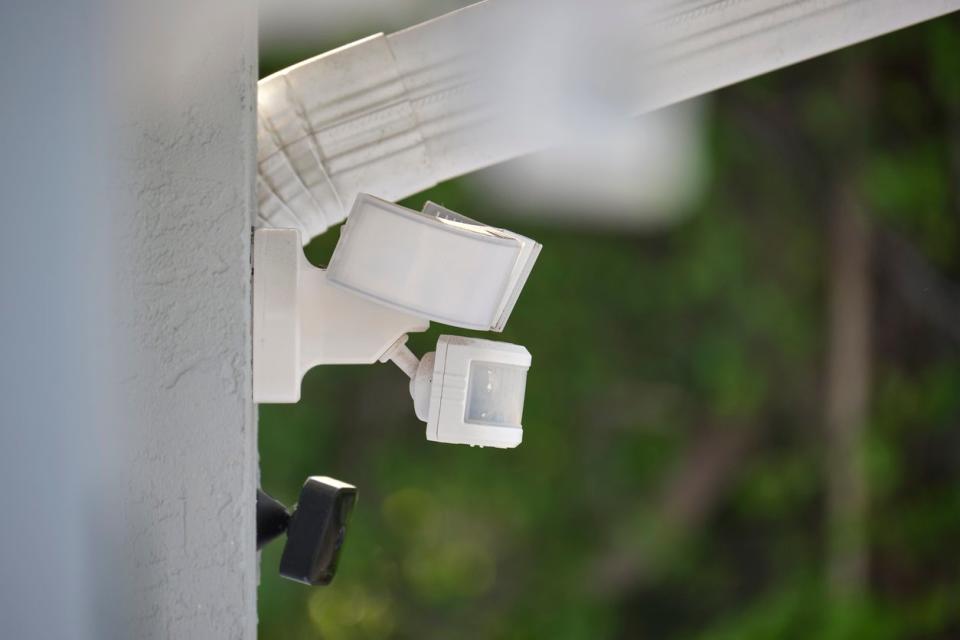
Photo: istock.com
Motion sensor lights are often used outside and can be floodlights or spotlights that can deter intruders.
When shoppers are looking for the best outdoor motion sensor lights, they’ll find that products largely fall into one of two categories: floodlights or spotlights. Both are capable of automatically turning on and off when motion is detected, and both are great additions to any home security system. However, there are several key differences between these two groups.
Floodlights tend to be much bigger in size and illuminate a larger area than spotlights. They usually consist of a central camera unit flanked by two large lights. These units can be moved and repositioned individually, allowing users plenty of flexibility when setting up the system. Some of the best floodlight cameras have two large floodlights can be tilted and angled independently of each other, making it easy for users to light up their yard without encroaching on a neighbor’s property.
According to Shahadi, “Outdoor cameras with motion-activated spotlights take motion-activated lights’ protection a step further. Not only will the outdoor camera trigger a light when motion is detected, but it will also send you an alert when it spots unexpected movement. Plus, when paired with professional monitoring, emergency response will be dispatched in the event of an emergency.”
Spotlights are typically much smaller than floodlights and are designed to light up specific areas. Frequently built directly into security cameras, spotlights look much more streamlined and compact. While they won’t be lighting up entire backyards, they’re great for illuminating porches, patios, balconies, or other concentrated areas around the property. Spotlights are great at improving front door security because of their small size and powerful lights.
Because they both produce light and are programmed to run automatically when motion is detected, spotlights and floodlights are great at deterring intruders. Shoppers will want to strongly consider why they’re buying a motion-sensing light before purchasing a spotlight or floodlight. If the whole yard or garage needs to be lit up, a floodlight is best. If a small area is the focus, a spotlight makes more sense.
Those who are adding floodlights to their garage will also want to consider the best garage lighting for the rest of the space, which can transform the typically dreary location and make it feel more inviting. Floodlights are a great first step toward improving garage lighting, but it’s also important for a user to consider adding LED bulbs, positioning fixtures in the right location, and adding additional motion sensors if needed.
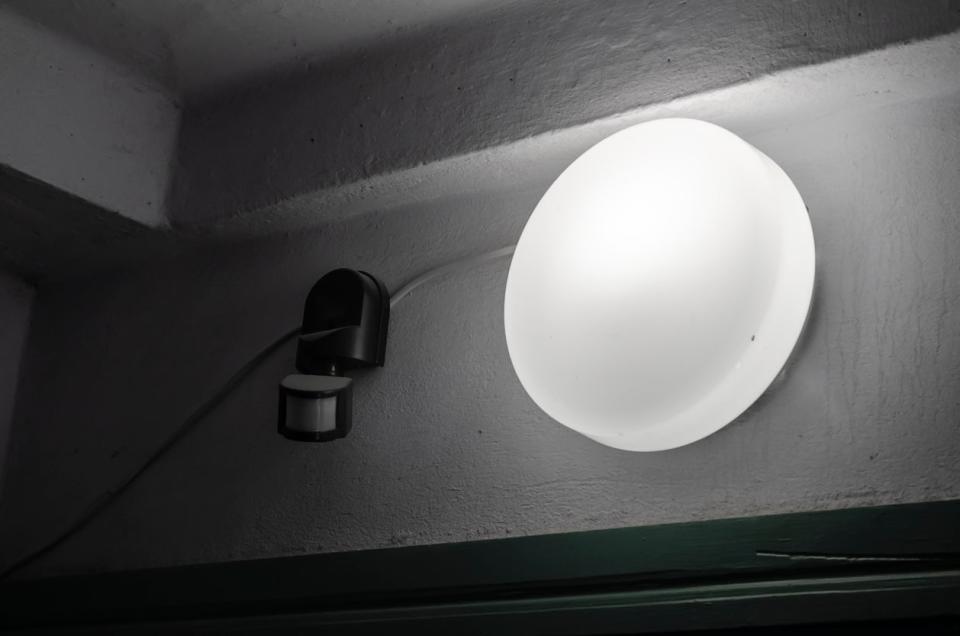
Photo: istock.com
Indoor motion sensor lights are usually more ambient in nature and can activate when someone enters the room.
Motion sensor lights for outdoor use are bright and cover fairly large areas. Motion sensor lights designed for indoor use are the opposite, offering an ambient glow and illuminating small areas. Indoor motion sensors for lights aren’t typically used for security purposes. While it’s possible for them to be used with a robust security system, many shoppers end up using them for convenience, as it allows them to navigate a dark hallway without needing to turn on a light. When these indoor devices sense someone nearby, they’ll turn on and produce a glow similar to that of a night-light. Then, once the motion has subsided, they’ll turn off.
“Indoor motion sensor lights are a great tool, even if they aren’t connected to a home security system,” says Shahadi. “Many people I know install motion sensor lights to simplify their lives. For instance, if your hands are full or if it’s too dark to find the light switch, motion sensor lights solve the issue by illuminating your room, no grocery juggling or fumbling needed.”
This functionality makes indoor motion sensor lights ideal for illuminating long hallways, bathrooms, or other areas of the home that might be visited at night. Not only do they provide a soothing ambience when tripped, but they’re also environmentally friendly and can reduce a home’s energy bills since they only activate when needed and turn off automatically.
Most indoor motion sensor lights don’t come with built-in cameras, meaning shoppers will want to pair them with a stand-alone indoor camera to better protect their property. Many security systems also use motion sensors without lights, which trip alarms or activate cameras when motion is detected instead of activating a light. Shoppers may want to consider buying smart light bulbs for motion detectors, allowing the two devices to communicate and turn on when movement is detected.
Another unique device for shoppers to consider is a light switch with a motion sensor. These motion sensors with light switches built directly into their frame work exactly how one would expect; they activate when nearby motion is detected and let off a tiny glow. They offer a variety of useful features, so shoppers will want to check out the best motion sensor light switches to find the best fit for their home.
Motion sensor lights can improve a home’s security—especially when paired with a comprehensive home security system.
Shoppers looking to build a reliable home security system will want to strongly consider motion sensor lights. Capable of illuminating large swaths of land (and capturing video if paired with a camera) they’re a great complement to standard security cameras. A bright motion sensor floodlight can help scare off intruders by startling them with brilliant lights.
When motion sensor lights are paired with security cameras, video doorbells, traditional motion sensors, and entry detectors, they offer a well-rounded security system that’s hard for intruders to avoid.
Motion sensor lights—more specifically, floodlights—are somewhat imposing. Unlike slim security cameras or sleek video doorbells, floodlights are bulky devices that quickly catch the eye. Unwanted guests who see the gadgets above garages or in a backyard might be inclined to leave the property before walking into their range, making floodlights great as a first line of defense. Some can even be programmed to offer a constant glow, letting intruders know they’re being filmed.
Indoor motion sensor lights aren’t quite as useful for home security, but they can make it easier to safely navigate a dark home.

